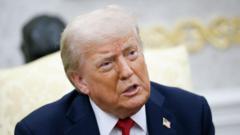Despite recent tariffs imposed by the Trump administration, China's economy continues to grow, supported by substantial investments and exports.
China's Economy Shows Resilience Amid Tariffs and U.S. Policy Changes

China's Economy Shows Resilience Amid Tariffs and U.S. Policy Changes
China's growth persists despite external pressures from U.S. tariffs and recent tech trade shifts.
China's economy demonstrated impressive resilience this spring, with official figures indicating a steady growth trajectory, even amidst the economic pressures of President Trump's imposing tariffs. Significant investments in manufacturing, infrastructure projects like high-speed rail, and a consistent outpouring of global exports have contributed to this growth trend. Companies reportedly ramped up their orders in anticipation of rising tariffs, which also played a role in sustaining the economy.
If the current growth momentum persists, analysts project that China's economy could expand at an annual rate of approximately 4.1 percent, a rate that is only marginally lesser than that observed in the opening quarter of the year. The release of China's GDP data coincided with the U.S. government's review of inflation figures, revealing that the tariffs imposed by Trump have begun to affect consumer prices, particularly for items subject to tariffs such as furniture, which experienced notable price increases in June.
In a noteworthy policy reversal, just three months after halting Nvidia’s A.I. chip sales to China, the Trump administration has allowed Chinese tech firms to resume their purchases of these critical chips. Additionally, China has announced restrictions on the transfer of eight essential technologies related to electric vehicle battery manufacturing, complicating plans for Chinese automakers looking to establish production facilities abroad amidst European Union pressures.
In diplomatic developments, Australian Prime Minister Anthony Albanese recently visited China for discussions with President Xi Jinping. This meeting aims to strengthen bilateral relations, all while navigating the complexities of U.S. influence in regional policies.
If the current growth momentum persists, analysts project that China's economy could expand at an annual rate of approximately 4.1 percent, a rate that is only marginally lesser than that observed in the opening quarter of the year. The release of China's GDP data coincided with the U.S. government's review of inflation figures, revealing that the tariffs imposed by Trump have begun to affect consumer prices, particularly for items subject to tariffs such as furniture, which experienced notable price increases in June.
In a noteworthy policy reversal, just three months after halting Nvidia’s A.I. chip sales to China, the Trump administration has allowed Chinese tech firms to resume their purchases of these critical chips. Additionally, China has announced restrictions on the transfer of eight essential technologies related to electric vehicle battery manufacturing, complicating plans for Chinese automakers looking to establish production facilities abroad amidst European Union pressures.
In diplomatic developments, Australian Prime Minister Anthony Albanese recently visited China for discussions with President Xi Jinping. This meeting aims to strengthen bilateral relations, all while navigating the complexities of U.S. influence in regional policies.




















